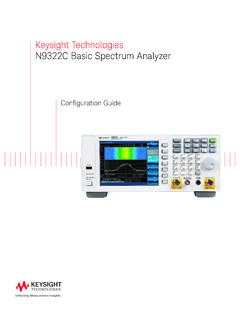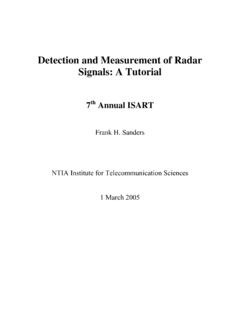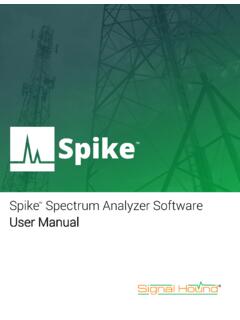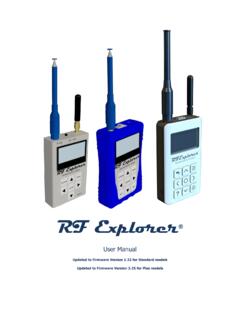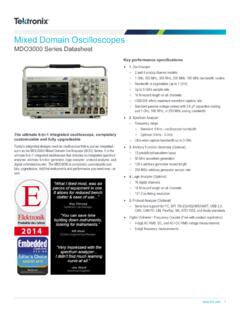Transcription of Application Note AN043 - Texas Instruments
1 Application Note AN043 Small Size GHz PCB antenna By Audun Andersen 1 KEYWORDS CC25xx CC24xx CC2480 PCB antenna USB dongle GHz Inverted F Antenna 2 INTRODUCTION The PCB antenna used on the CC2511 USB dongle reference design is described in this Application note. Even if the antenna presented is for a USB dongle design it can be used in all GHz designs, especially where small space is required for the antenna. This Application note describes the antenna dimensions, the RF performance and considerations for complying with regulatory limits when using this design.
2 The suggested antenna design requires no more than x mm of space and ensures a VSWR ratio of less than 2 across the GHz ISM band when connected to a 50 ohm source. Figure 1: CC2511 USB Dongle SWRA117D Page 1 of 21 Application Note AN043 Table of Contents 1 2 3 4 ANTENNA DESIGN LAYOUT AND 5 TEST RADIATION OUTPUT SPURIOUS EMISSION AND 6 CONCLUSION ..20 7 GENERAL DOCUMENT 3 ABBREVIATIONS CAD Computer Aided Design CC24xx CC2400, CC2420, CC2430 and CC2431 CC25xx CC2500, CC2510, CC2511, CC2550 and CC2520 CC2480 Z-Accel ZigBee Processor IFA Inverted F Antenna ISM Industrial.
3 Scientific and Medical LOS Line Of Sight PCB Printed Circuit Board PER Packet Error Rate VSWR Voltage Standing Wave Ratio SWRA117D Page 2 of 21 Application Note AN043 4 ANTENNA DESIGN The PCB antenna on the CC2511 USB dongle reference design is a meandered Inverted F Antenna (IFA).
4 The IFA was designed to match an impedance of 50 ohm at GHz. Thus no additional matching components are necessary. Design Goals The reflection at the feed point of the antenna determines how much of the applied power is delivered to the antenna. A reflection of less than -10 dB across the GHz ISM band, when connected to a 50 ohm source, was a design goal. Reflection of less than -10 dB, or VSWR less than 2, ensures that more than 90% of the available power is delivered to the antenna. Bandwidth is in this document defined as the frequency band where more than 90% of the available power is delivered to the antenna.
5 Another design goal was to fit the size of the PCB antenna on a USB dongle and to obtain good performance also when the dongle is connected to a computer. Simulation IE3D from Zeland, which is an electromagnetic simulation tool, was used to design the antenna. The accuracy of the simulation is controlled by the mesh. An increase of the mesh increases the simulation time. Thus, for initial simulations mesh = 1 should be used. When a fairly good result is achieved a higher mesh should be used to obtain more accurate results.
6 Comparison of simulation and measurement results shows that the measured reflection is between the result obtained with mesh = 5 and mesh = 1; see Figure 2 for details. Figure 2: Comparison of Simulation and Measurements Results SWRA117D Page 3 of 21 Application Note AN043 Layout and Implementation Small changes of the antenna dimensions may have large impact on the performance. Therefore it is strongly recommended to make an exact copy of the reference design to achieve optimum performance.
7 The easiest way to implement the antenna is to import the gerber or DXF file showing the antenna layout. These files are named and respectively and are included in the CC2511 USB dongle reference design available from \lpw. The imported file can be used as a template when drawing the antenna. By using this procedure it should be possible to make an exact copy. If the PCB CAD tool being used does not support import of DXF or gerber files, Figure 3 and Table 1 should be used to ensure correct implementation.
8 It is recommended to generate a gerber file for comparison with when making a manual implementation. Most gerber viewers have the possibility to import several gerber files at the same time. Thus by placing the gerber file, showing the manually implemented antenna, on top of it is easy to verify that the antenna is correctly implemented. It is also recommended to use the same thickness and type of PCB material as used in the reference design. Information about the PCB can be found in a separate readme file included in the reference design.
9 To compensate for a thicker/thinner PCB the antenna could be made slightly shorter/longer. Figure 3: Antenna Dimensions L1 mm L2 mm L3 mm L4 mm L5 mm L6 mm W1 mm W2 mm D1 mm D2 mm
10 D3 mm D4 mm D5 D6 mm Table 1: Antenna Dimensions SWRA117D Page 4 of 21 Application Note AN043 5 TEST RESULTS Reflection, radiation pattern and variation of output power across a wide frequency band were measured to verify the performance of the PCB antenna. Measurements of the dongle in free space and when connected to a laptop were performed to verify that the antenna is suitable both for USB dongle designs and in a standalone Application .










